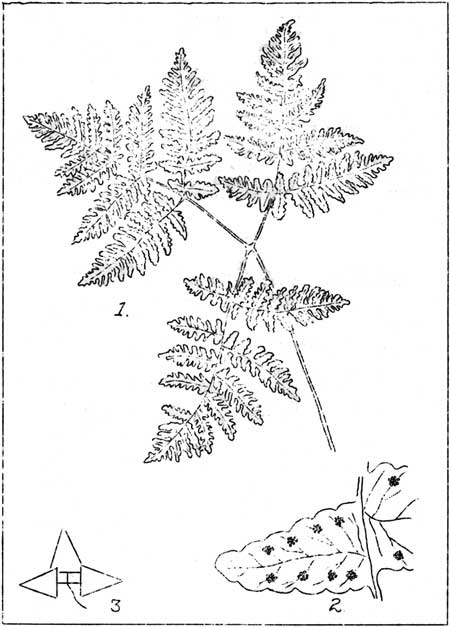 |
|
1. Frond of the Oak
Fern (Dryopteris linnaeana) illustrating the arrangement of
the three triangular shaped pinnae upon the slender stalk. 2. Pinnule
(underside) illustrating sessile character and form and position of sori
(x8). 3. Diagramatic sketch of pinnae arrangement.
|
OAK FERN.
(Dryopteris linnaeana C.
Chr.)
A very beautiful delicate herbaceous fern, common in certain areas in
the deep shaded woods of the Canadian zone. It prefers a moist, cool,
shady habitat and rich humus. It is quite common on rotting
logs. Generally its botanical range includes the area from
Alaska to Greenland and south to Oregon, New Mexico, Arizona, Kansas,
Michigan and Virginia. It is also known in Asia and Europe. The
local range is from the lower park boundaries to about 3500'.
The fronds are 2-3 compound. The slender brownish leafstalk is
divided about 5-14 inches above the earth into three pinnae of almost
equal size, broadly triangular and spreading almost at right angles to
the stem and in a horizontal plane. These pinnae are 3-10 inches
wide at the base, almost equilateral in form. Pinnules sessile
with crenate margins; stalk of pinnae bordered with green "wings".
Spores borne in small round sori which are nearer the margin than
the mid-vein. There is no indusium. Veins free. Rhizome
cord-like, widely creeping with scattered fronds.
SYNONYMS: Polypodium dryopteris L.; Polypodium disjunctum
Rupr.; Thelypteris dryopteris Slosson; Phegopteris dryopteris Fee.
-oOo-
SIERRA WATER FERN or STREAM FERN.
(Dryopteris oregana C. Chr.)
An uncommon plant in Mount Rainier National Park. It is also unique
in that he only collection of this species in the State of Washington
(so far as is known) was made in the park. This collection, made by
Prof. J. B. Flett on Aug. 22, 1929, near the Paradise-Ohanapecosh trail
about three miles from the old Ohanapecosh Ranger Station, is included
in the Park Herbarium in the Museum at Longmire. It prefers, as its
habitat, the moist shaded woods of the Canadian zone along
streams. It was in such a situation at an altitude of 3000' that Prof.
Flett collected the specimen mentioned. Its botanical range
includes an area along the Pacific Crest from British Columbia to
California; the local range has not, due to lack of sufficient
specimens noted, been determined but no doubt it may be encountered on
rare occasions below 3000' in its preferred habitat. The fronds are
tufted; one compound; 15-30 inches long; elliptic-lanceolate in outline;
3-5 inches wide at widest point which is about the middle and tapering
toward both ends. Even the largest pinnae are practically
sessile and the plant is herbaceous. Margins of segments entire
and sometimes crenate. Spores borne in small sori which are
placed neared the mid-vein than the margin. Indusium present but
minute. Rhizome creeping and slender.
The common names refer to the characteristic habitat - along stream
borders and, possibly, to its presence in the Sierras of California.
SYNONYMS: Aspidium nevadense C. C. Fason; Dryopteris
nevadensis Underw.; Thelypteris oregana St. John.
-oOo-

